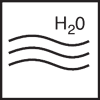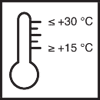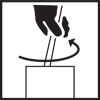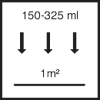Article No. 165620
Water-based, all-in-one coating system with insulating effect for dimensionally stable building elements
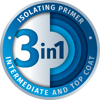

Product specifications
The stated values represent typical product characteristics and are not to be construed as binding product specifications.
Field of application
- For use on interior and exterior wood
- Soft and hard woods
- Dimensionally stable wood building elements: e.g. windows and doors
- Primer, intermediate and finishing coats
- Single coat and multi-coat procedure
Properties
- 3-in-1: sealing primer, intermediate coating and top coat
- Good filling properties with good flow
- High hiding power
- Isolating effect against substances contained in the wood
- Low waiting time until material is fit for use
- Increased block resistance
- Early resistance to water: minimises the risk of damage, e.g. to "winter constructions"
- Special combination of binding agents creates an extremely hard-wearing surface
- Very good hail resistance: elasticity at low temperatures
- Dirt-resistant
-
Preparation
-
Substrate requirements
The substrate must be clean, dry, free of dust, grease and loose substances, and prepared in the correct manner.
Dimensionally stable wood building elements: wood moisture content 11-15%
-
Preparations
If necessary, impregnate non-resistant woods with a wood preservative* (*Use biocides safely. Always read the label and product information before use).
Pre-treat using a suitable primer & intermediate coat and carry out intermediate sanding if necessary.
If necessary, protect parapet joints with Induline V-Joint Protection or Induline AF-920.
-
-
Application
-
Application requirements
Temperature of material, environment and substrate: min. +15 °C up to max. +30 °C.
-
The values given are based on undiluted material. The best spraying pattern is achieved if the material has a temperature of 15-20 °C.
Stir well.
Airless spraying: nozzle size: 0.28-0.33 mm; material pressure: 90-120 bar.
Air-mix spraying: nozzle size: 0.28-0.33 mm; material pressure: 70-90 bar, atomiser air pressure 1-2 bar.
After priming, carry out light intermediate sanding.
Carry out intermediate sanding before applying a final coat: P 220-240, remove sanding dust.
Seal opened containers well and use contents as soon as possible.
-
Application instructions
-
Check colour, adhesion and compatibility with the substrate by setting up a trial area.
Before coating technically modified woods and wood-based materials, apply the product to a trial surface and conduct a suitability test on the desired area of use.
Ensure good ventilation.
Do not use in direct sunlight or at temperatures below +15 °C or above +30 °C.
Recycling is possible via the standard channels. Liaise with Remmers Technical Service if coatings have been mixed.
To prevent the penetration of coloured wood ingredients, apply the product several times or use suitable insulating primer and intermediate coatings.
With water based coating systems, there is always a residual risk that substances contained in the wood will cause discolouration.
The product's sealing effect may be impaired if it is diluted too thinly, if the wood is too wet or if the recommended coating sequence, application volumes and drying times are not observed.
Bleeding resin is a natural phenomenon and cannot be prevented by coating measures, see BFS Code of Practice No. 18.
The specifications of VFF Code of Practice HO.03 must be observed with regard to the permitted dry layer thicknesses.
Observe current standards and guidelines for coating wood building elements outdoors (Codes of Practice issued by the German Association of Window and Facade Manufacturers (VFF), Code of Practice No. 18 issued by the German Federal Committee for Paint and the Protection of Material Assets (BFS), guidelines issued by the German Lacquer and Printing Ink Association (VdL) and ift guidelines issued by the Institut für Fenstertechnik).
The system finder on our website www.remmers.com contains coating recommendations for specific wood types to be used when treating windows and exterior doors.
-
Thinning
If necessary with water (max. 5 %).
-
Working tools / cleaning
-
Airless/airmix spraying systems, electrostatic systems, Dynflow systems
-
Clean tools with water or Aqua RK-898 Cleaning Concentrate immediately after use.
Ensure that any residue from cleaning is disposed of correctly.
-
Storage / shelf life
-
If stored unopened in its original container in a cool, dry place and protected against frost, the product will keep for at least 24 months.
-
Usage
-
Two spray applications:
150 - 175ml/m² each (plus spray loss).
(corresponds to wet film thickness: 150 - 175 µm, dry film thickness: 55 - 65 µm)
Single spray application:
300 - 325 ml/m² (plus spray loss).
(corresponds to wet film thickness: 300 - 325 µm, dry film thickness: 110 - 120 µm)
Use as one-pot system max. dry film thickness total structure: 150 µm -
Colour deviations are possible.
-
General information
-
Sealing:
Sealing compounds must be compatible with the coating and may only be applied once the coating has dried thoroughly.
Only use sealing profiles that are free of plasticisers.
Production of a brushing quality:
Add 10 - 20% water to this product to obtain a coating that can be applied by brush for touch-ups.
Care and maintenance:
Wood is subjected to great climatic and environmental stresses when outdoors. The coat is susceptible to the processes of natural ageing, wear and decomposition. Decomposition takes place at different speeds, depending on the stress (weak, average, strong) placed on the wood building element. Weathering stages may vary according to the part or element affected. To give wood the longest and best possible protection it is advisable to examine surfaces every year. Any damage found should be addressed immediately after cleaning.
For cleaning and care, we recommend the care set for windows (2745) and doors (2746).
Use Aqua AG-26 Universal Primer and Aqua DL-65 Opaque Top PU or Aqua VL-66/sm Venti-Coat 3in1 for reconditioning coats.
Observe current standards and guidelines for coating wood building elements outdoors (Codes of Practice issued by the German Association of Window and Facade Manufacturers (VFF), Code of Practice No. 18 issued by the German Federal Committee for Paint and the Protection of Material Assets (BFS), guidelines issued by the German Lacquer and Printing Ink Association (VdL) and ift guidelines issued by the Institut für Fenstertechnik).
-
-
Disposal instructions
-
Larger quantities of leftover product should be disposed of in the original containers in accordance with the applicable regulations. Completely empty, clean containers should be recycled. Do not dispose of together with household waste. Do not allow to enter the sewage system. Do not empty into drains.
-
-
Safety / regulations
-
For further information on the safety aspects of transporting, storing and handling the product and on disposal and environmental matters, please see the current Safety Data Sheet.
-




